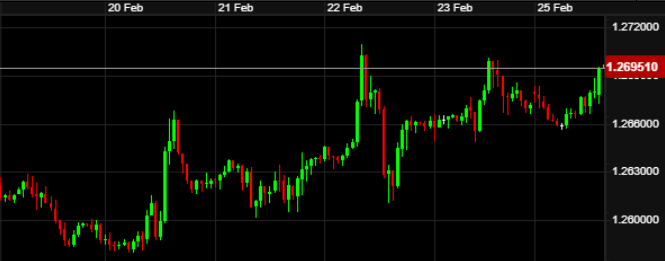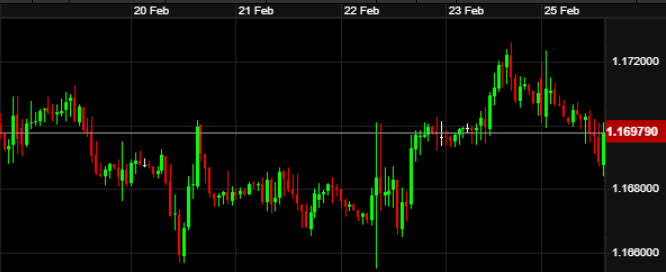ACM Update 26-02-24

With minutes from the most recent Federal Reserve and European Central Bank meetings both released last week, we saw plenty of volatility. Both committees seem wary of cutting interest rates too soon, leading market expectations to be realigned once again.
The week coming will provide further evidence of US economic performance with GDP data, as well as the next round of G20 meetings in Sao Paolo.
UK economic data remains very much mixed, but sterling saw support last week from monetary policy stance softening in both Europe and the US. Or at least for now. More to come on that.
The Bank of England Governor, Andrew Bailey, found himself in front of his regular Treasury Select Committee panel last Tuesday, handling questions about the economy. He reaffirmed recent opinions that despite the UK dipping into a recession at the end of 2023, the economy is already picking up as we start 2024. We may well indeed already be past the bottom of the dip.
With inflation still running hot on UK shores, Bailey remains “comfortable” with the outlook of rate cuts currently expected by markets. This has recently realigned to the first cut to come in either June or August’s MPC meeting. He also continued to reaffirm that the Bank will not be waiting for inflation to hit 2% before starting rate cuts.
One member of the committee who is keen to press on with rates cuts is (and always has been) Swati Dhingra. She also spoke last week with an artistically titled speech, “money’s too tight (to mention)”, in which she reaffirmed her concerns about ongoing scars for the economy if rates aren’t cut soon. Former MPC member Andy Haldane had similar beliefs when questioned recently on the topic.
That said, a majority decision will be needed and with the lion’s share still believing it too early to cut, interest rates in the UK seem likely to remain at their current level for the first half of 2024.
In data releases, UK consumer confidence fell in February. This implies households are not ready to spend quite yet, despite the green shoots of economic growth that have been reported. The metric dropped by circa 2%, ending a three-month spell of positivity.
UK services sector PMI data (services forming over 75% of the economy) is performing well in February, recording its best figure since May last year. The manufacturing sector remains sluggish though. The services figure was enough to give GBP a boost on Thursday morning which carried it through until the weekend.
Overall a buoyant week for GBP as illustrated in the chart below against the Dollar:

After the US bank holiday last Monday, the Federal Reserve meeting minutes were the biggest takeaway of the week, landing on Wednesday evening. These reaffirmed comments from the Jerome Powell press conference two weeks prior, suggesting that the prospect of cutting rates was still a way off yet.
Present concerns remain about cutting rates too soon and the risks that this may cause, rather than keeping them too high for too long. This is especially backed up by the current performance of the US economy. Policymakers currently want to see more evidence that inflation is on a steady path back down to their 2% target, before entertaining reducing interest rates.
The minutes reaffirmed the fact that interest rates will be remaining higher for longer in the US, which offered support to the US Dollar throughout the week.
This sentiment was then reaffirmed the day after, with comments from three Federal reserve members all following the same rhetoric that rates should still be cut this year, just not imminently. Having seen a nudge up in inflation in January, Fed members Philip Jefferson and Lisa Cook want more evidence that CPI inflation is heading to 2% before lowering interest rates. Meanwhile, Christopher Waller urged caution in cutting too soon.
US jobs data last week also looked positive, which bodes well for the release of February’s Non-Farm Payrolls data (released 8th March). The number of new unemployment claims in the US grew by less than expected, their best figure in five weeks.
The minutes of the most recent European Central Bank meeting were also released on Thursday, with Frankfurt seemingly on a very long road to cutting interest rates. The last few meetings have seen the ECB keeping perched on the fence, without any real changes in policy. This remained the same again, with just subtle changes in language the only differentiator.
Rate cuts in the first few meetings of the year seem very unlikely now, as the bank suggested they will want to wait to see if Q1 data shows a raft of changes, before adapting policy. These metrics include inflation falling, some degree of an economic recovery and no drastic changes in wage growth. Indeed, Frankfurt now seem to be more focussed on the economy rather than the current inflationary pressures.
For now it seems then that the March meeting may not yield the interest rate cuts which many had hoped for. Especially given the fact that the above mentioned Q1 inflation figure won’t be released until mid-April.
The most recent inflation release last week was the “Final CPI” figure for January, showing inflation now sitting at 2.8% in the bloc, lower than the equivalent in the UK and the US. With their slow move to hike rates two years ago, the EU certainly wasn’t expected to be leading the pack on falling inflation figures.
One sizeable concern is that German data remains very weak, with both the manufacturing and services sectors indicating contraction for February. French data is not far behind either using the same metrics.
Overall sterling enjoyed the upper hand throughout the week against the Euro, as seen in the chart below:

The week ahead:
Monday – MPC Huw Pill speech (11:00 UK time), ECB Christine Lagarde speech (16:00)
Tuesday – MPC Dave Ramsden speech (13:40), US Consumer Confidence (15:00)
Wednesday – Australian CPI inflation (00:30), RBNZ interest rate announcement (01:00), US Prelim GDP (13:30), G20 Meetings start
Thursday – German Prelim CPI inflation (07:00), UK Mortgage Approvals (09:30), US Unemployment Claims (13:30)
Friday – EU Manufacturing PMI (09:00), UK Manufacturing PMI (09:30), EU CPI Flash Estimate exp 2.5% (10:00), MPC Huw Pill speech (14:00), Fed Raphael Bostic speech (15:50)
Higher for longer and less cuts now seems to be the mantra for 2024 at the major central banks. Both the Federal Reserve and ECB seem to have moved towards this rhetoric, following what the Bank of England have been trying to convince markets for some time. Geopolitical events were the main drivers behind the latest round of rate hikes, so it seems natural to be wary of further occurrences when considering when to cut. Caution is becoming the name of the game.
The longer this goes on, the more sterling seems to be gradually benefitting from the situation. The Bank of England declared early that this would be their strategy and so it seems. But the nine-member committee only needs a few policymakers to change their perspective and all of a sudden we could well be close to a cut.
There are a number of speeches from various corners of the Monetary Policy Committee this week, so these could well be sterling drivers.
With limited actual data releases this week, we expect sterling to remain somewhat rangebound outside of the above speeches. The main event will be the US Preliminary GDP figure for Q4 of 2023, forecast to show a quarterly growth of 3.3% compared to Q3. Another great sign for the US economy if true, and another reason why the Federal Reserve won’t consider cutting interest rates any time soon.
Eurozone movements will be focussed around a speech from Christine Lagarde on Monday and a mix of German data landing throughout the week. The Euro has been regaining ground against a softer Dollar, which seems to be continuing into the new week.
For now, both GBP-USD & GBP-EUR remain favourable for those selling GBP. Make sure to reach out to the Aston team for any requirements moving funds in this direction.
Have a great week.